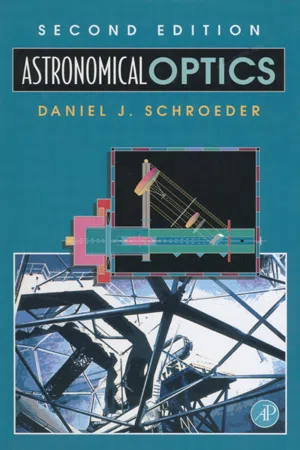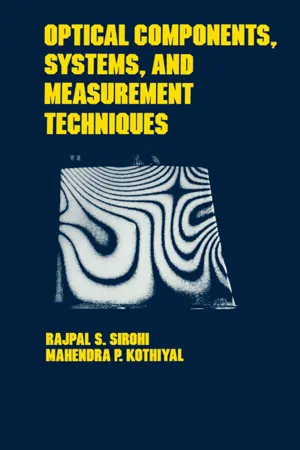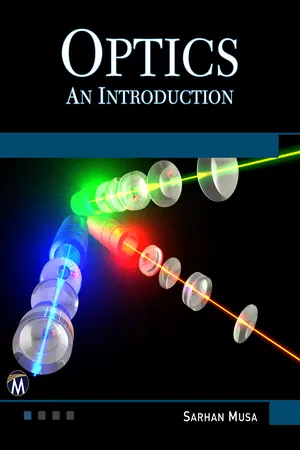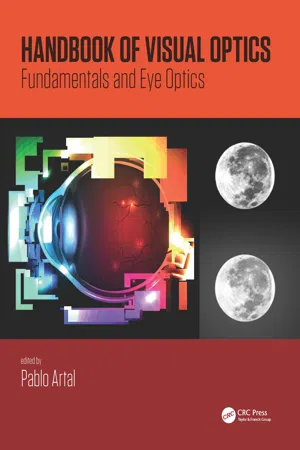Physics
Field Curvature
Field curvature is a phenomenon in which the image formed by a lens is not flat but curved. This occurs because the lens is unable to focus all points in the image plane at the same distance from the lens. As a result, the image appears distorted towards the edges of the field of view.
Written by Perlego with AI-assistance
Related key terms
Related key terms
1 of 4
Related key terms
1 of 3
5 Key excerpts on "Field Curvature"
- eBook - ePub
- Jeremy Sanderson(Author)
- 2019(Publication Date)
- Wiley(Publisher)
Figure 6.12 ). This is because the off-axis marginal image-forming rays travel a slightly longer distance than the paraxial rays. Field Curvature leads to a sharp image in the centre of the field of view but blurring at the periphery. It is not possible to secure an image that is both sharp in the paraxial region as well as at the margins of the field of view. As with other aberrations, Field Curvature is particularly obvious with objectives of high initial magnifying power and large numerical aperture. This aberration is not so serious with visual observation, partly because of the natural accommodation of the eye, but also because it is easy to adjust the fine focus as required while scanning the field of view.Source: Pluta 1988.Figure 6.12Image Field Curvature Field Curvature often occurs, panel (a), in conjunction with astigmatism. In panel (b) the astigmatism has been corrected, leaving only Field Curvature. In panel (c) Field Curvature has also been corrected.Because the plane of the film/CCD faceplate is flat, Field Curvature is particularly noticeable in photomicrography. The most obvious way to reduce Field Curvature is only to record the central part of the field of view. The other way is to use flat-field objectives corrected for image Field Curvature. This is done by distributing8 the overall Field Curvature between the several individual lens elements that comprise the objective, or optical component. Old microscope objectives (Figure 6.13 ) will not be corrected for Field Curvature, for it was not until 1938 that Hans Boegehold, working for Carl Zeiss, solved this problem. Modern objectives are now routinely made as flat-field objectives, which usually have the prefix ‘F’ or ‘Plan’ in their name.Figure 6.13Field Curvature in the image Images showing Field Curvature. These images are of the same field of view as for Figure 6.2 showing spherical aberration. The top-left panel is taken with a 10:1/NA 0.22 achromatic objective from circa 1980. The lower-left panel is taken with a 10:1/NA 0.30 achromat dating from 1909. Both are non-plan objectives (unlike that used to take Figure 6.2 - eBook - ePub
- Daniel J. Schroeder(Author)
- 1999(Publication Date)
- Academic Press(Publisher)
4.8 (it does not appear in Eq. (4.4.1)); the aberration is called curvature of field. Its character is most easily seen by noting that the transformation that takes the origin from O to O’ is essentially one of a rotation about the center of curvature C. Thus the motion of point B in Fig. 4.8 to B′ is along a circular arc whose center is C. The foci for different θ, in the absence of other aberrations, are located on a curved surface, hence the name curvature of field. At this stage five third-order aberrations have been identified: spherical aberration, coma, astigmatism, distortion, and curvature of field. The first of these is independent of field angle, but all others depend on some power of θ. The first three aberrations in this list affect image quality, while the last two affect only image position. From Eqs. (4.2.7b) and (4.4.1) we see that the transverse aberrations depend on aperture radius y (or r) and field angle θ according to the relation (4.4.2) where n + m = 3. Hence each of these aberrations is called a third-order aberration. The main task in the analysis of the image quality in any optical system is the determination of how much of each of these aberrations is present, and then eliminating or reducing the amount of each by proper selection of system parameters. 4.5 ABERRATION COMPENSATION In Section 3.7 we noted that a perfect optical system is one in which the wavefront emerging from the final surface is spherical. From the discussion in this chapter it is evident that there is a close relation between deviations from a spherical wavefront and the appearance of aberrations - Rajpal S. Sirohi, Mahendra P. Kothiyal(Authors)
- 2017(Publication Date)
- CRC Press(Publisher)
Fig. 3.2 ). Rays 1 and 2, passing through the lens at a larger aperture, come to focus at a height different from that of the central ray 3, which gives the paraxial image height. Coma is a nonsymmetrical aberration and produces an asymmetrical intensity distribution in the image of a point object. This makes the accurate determination of image position difficult, so that error in precision measurements occurs. Coma varies with the shape of the lens elements and is a function of the square of the aperture of the lens and the image height.Figure 3.2 Coma.AstigmatismLike coma, astigmatism is an off axis aberration. A point located away from the axis is imaged by the lens as two orthogonal lines separated along the optical axis as shown in Fig. 3.3. Between these two lines the image is an elliptical or circular patch. The distance between the lines is a measure of astigmatism. Astigmatism is a function of the image height and varies with the lens shape.Field CurvatureWhen the focused image of a plane object does not lie on a plane but on a curved surface, the optical system is said to have Field Curvature (also called Petzval curvature). When astigmatism is present, two curved surfaces corresponding to the two astigmatic foci are produced that are away from the Petzval surface (Fig. 3.4 ). Petzval curvature depends on the index of refraction, the curvatures of the lens, and the square of the image height. Positive lenses introduce inward curvature and negative lenses introduce backward curvature.Figure 3.3 Astigmatism.DistortionDistortion is an aberration in which the image of an off-axial point is displaced from its position given by the paraxial equations, the displacement being a function of the image height. The effect is demonstrated when we consider the imaging of a square object (Fig. 3.5 ). Depending on the direction of displacement we have pincushion or barrel distortion. Distortion is a serious aberration if measurements are made on the image. If the object and image planes are interchanged, the type of distortion is also interchanged.Chromatic AberrationThe refractive index varies with the wavelength of the light, and consequently the focal length of a lens is not the same for all colors. As a result, light of different wavelengths comes to focus at different points along the axis, so that longitudinal chromatic aberration results. Similarly, the height of an image varies with a change in wavelength, so that transverse chromatic aberration results.- eBook - ePub
Optics
An Introduction
- Sarhan M. Musa(Author)
- 2020(Publication Date)
- Mercury Learning and Information(Publisher)
Figure 4.19 , astigmatism may be eliminated completely.FIGURE 4.19. Correction for astigmatism.4.4 CURVATURE OF FIELDEven if the lens system is free from spherical aberration, coma, and astigmatism, that is, the zonal focal length of the system does not vary from its axial focal length for off-axial object points, the image of an object plane is, in general, a curved surface. This is due to the reason that since off-axial object points are farther away from the lens system than the axial point, in the case of a convergent lens forming a real image, the image of an off-axial object point is formed closer to the lens than the image of the axial object point, thus accounting for the curvature of the image shown in Figure 4.20 .FIGURE 4.20. Curvature of field.In a convergent system the radius of curvature of the image surface is negative, and hence the curvature is designated as negative, while the converse of this holds true in a divergent system, the concave side being toward the object in the former system while away from the object in the latter system. As a result, by their suitable combination, as explained later on, the image can be flattened. The curved image surface due to single lens refraction is called the Petzval surface, and the aberration is known as curvature of field.4.4.1 Reduction or Elimination of Curvature of Field1. For a system of thin lenses, the curvature in the final image is given by(4.11)Hence, for no curvature the condition is that . In the case of two lenses, this condition reduces to(4.12)where μ1 and f1 are the refractive index and focal length of one lens, and μ2 and f2 are the refractive index and focal length of the second lens. This condition for no curvature is known as the Petzval condition, and it holds whether the lenses are in contact or separated. Since μ1 and μ2 are positive, hence f1 and f2 must be of opposite signs. Thus, by employing a convergent and a divergent lens of different materials and satisfying the Petzval condition, the curvature of the image can be eliminated, resulting in a flat field. If f1 refers to the convergent component, then for the combination to also be convergent, it is essential that f2 must be greater than f1 . Therefore, in order that Equation (4.4b) may be satisfied, it is essential that μ2 must be less than μ1 - eBook - ePub
- Pablo Artal, Pablo Artal(Authors)
- 2017(Publication Date)
- CRC Press(Publisher)
The net effect will be that tangential rays are refracted more, creating an astigmatic error with two separate line foci. The tangential line focus will be a line perpendicular to the tangential plane and located closer to the anterior part of the eye than the sagittal line focus, which forms a line in the tangential plane. The power of a correcting negative cylinder will be oriented along the tangential plane. In the example earlier the axis of a negative correcting cylinder would then be 90°. The lines in Figure 21.3 show the orientation of the tangential plane (and hence the sagittal line foci) for eight different field locations. The amount of off-axis astigmatism can be approximated by the Coddington equations (see Section 7.4.1 of Freeman and Hull 2003). 21.2.2 DEFOCUS DUE TO Field Curvature Defocus means that the circle of least confusion is not located on the retina. It depends on the optical power, the length of the eye, and the distance to the object. If an object is moved perpendicularly further away from the optical axis of a system in a flat plane, the distance from the system to the object will increase. For a positive system, such as the eye, this means that the further the object is moved off-axis, the closer the image will be to the system, resulting in a curved image plane. This aberration is called Field Curvature and would mean that the eye becomes more myopic in oblique angles. However, as the retina of the eye is curved, it is the offset between the image plane and the retina that matters. In Section 21.4.1, it is shown that the circle of least confusion of the peripheral eye can be located both in front of and behind the retina depending on the shape of the eyeball, which in turn depends on the central refractive error of the eye. Figure 21.3 The visual field as seen by the right eye
Index pages curate the most relevant extracts from our library of academic textbooks. They’ve been created using an in-house natural language model (NLM), each adding context and meaning to key research topics.
Explore more topic indexes
Explore more topic indexes
1 of 6
Explore more topic indexes
1 of 4




